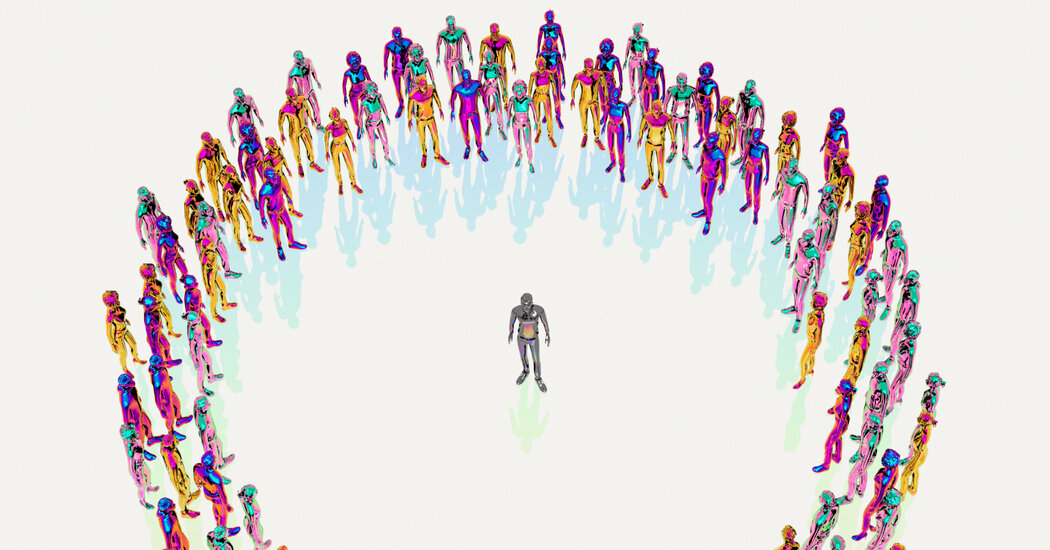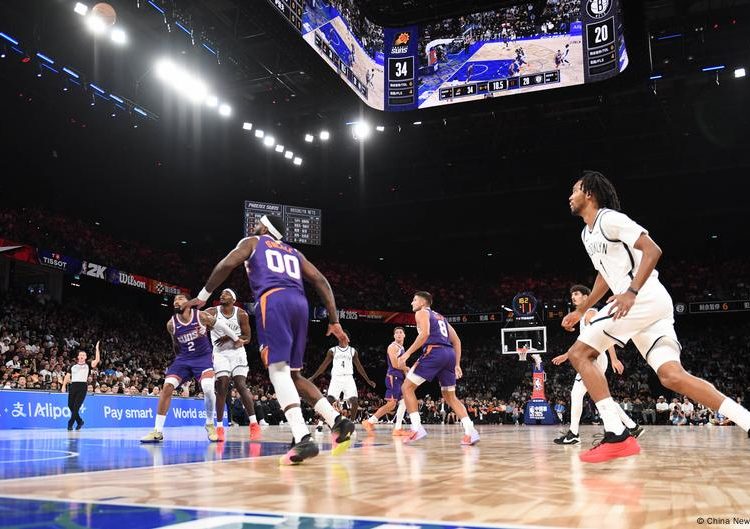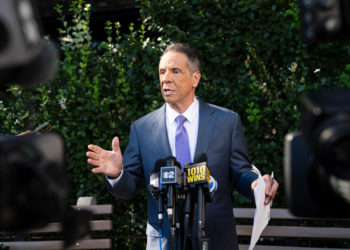In an austere warehouse, a very-online political pundit sits at a small desk. Sometimes it’s a conservative — Candace Owens, say — and sometimes it’s a progressive, like Mehdi Hasan. No matter who it is, the format is the same: The star is surrounded by a mob of 20 people who rush the desk, vying for the chance to argue against the professional rhetoricians over inflammatory proposals like “the sexual revolution has devalued women and made them infinitely less happy” or “Donald Trump’s plan for Gaza is ethnic cleansing.” Over the course of about 90 minutes, everyone in the circle gets a go.
Officially, there are no winners in “Surrounded,” a provocative YouTube series produced by the digital media company Jubilee. But millions of viewers delight in watching people just like them confront famous ideological foes.
“Surrounded” takes up some of the hottest button issues of the day, but — much like a physical version of an internet comments section — the videos are not really about changing anyone’s mind. What gives them their charge seems to be less about the content and more about the form itself: one star of the digital commentariat versus a crowd of regular people.
This one-against-many gimmick has become the internet’s format du jour. Recently, on a hazy rooftop in Dubai, the masculinist influencer Andrew Tate sparred against his fans, one after another, 60 men in all. Earlier this year, in an apartment in London, the outrage-courting OnlyFans star Bonnie Blue had sex with more than 1,000 of her fans over a marathon 12-hour day.
(It’s also circulating more broadly in social media culture. A recent debate that circulated widely on TikTok, X and Reddit centered on the question of whether 100 men picked at random could defeat a single gorilla in a fight to the death. So far, no gorillas have thought to cash in.)
Put aside the specific kind of intercourse — verbal, pugilistic, sexual — and it’s clear that these recent spectacles literalize the imbalance of the relationship between social media celebrities and their audiences. They exploit this by turns admiring, antagonistic and perverse dynamic to produce viral content.
The staged intermingling of stars and their audiences is a staple of modern celebrity culture. But one-versus-all stunts promise fans more than just autographs or selfies. They physically embody interactions once confined to bytes and screens. The fan who wonders if Mr. Tate would consider him a “top G” now has the chance to fight him. The X commenter engaged in a rolling mental dispute against the conservative provocateur Ben Shapiro now has the chance to take him on in person. The fan who pays Ms. Blue for her videos now has a chance to, well, live out what he’s seen.
Today, digital culture is a parasocial mille-feuille, layers of which we all consume in some way. Talk shows that mimic the intimacy of close friendship dominate podcast charts. Group chats obsess over minutiae in the lives of famous and nonfamous people — characters — their members love, loathe, laugh at, lust over. Digital invitation platforms like Partiful link to social media profiles, turning every potential party guest into an object of fascination. The platform internet invites us to build our own imaginary social worlds out of information about people who do not know us. And we oblige.
That’s why these one-on-many stunts are not just stunts. They are dramas that enact the complex interplay between creators and the nameless masses to whom they owe their success. More than this, they are a new frontier in the parasocial, the traditionally one-sided exchanges between audience and star that define modern digital culture. Call them the parasocial battle royale: the persona vs. the masses.
The Rise of Personae
When the sociologists Donald Horton and R. Richard Wohl coined the term “parasocial interaction” in 1956, they were describing the popular media of the midcentury: radio, film and especially television. The academics described a culture in which audiences felt personally involved in the lives of performers, who could not necessarily reciprocate those feelings of closeness.
Mr. Horton and Mr. Wohl noted the rise of figures they called “personae,” personalities like announcers, quizmasters and radio hosts, who had no special skill except their ability to cultivate these asymmetrical relationships with their audience. (One early persona was the Lonesome Gal, a kind of radio girlfriend for the lonely men of the 1940s.)
Parasocial interactions could provide the “social elixir of sociability” for those who were “socially and psychologically isolated,” the men wrote in “Mass Communication and Para-Social Interaction.” But on some level, no matter how deep the illusion, the audience knew these interactions were unrequited.
Celebrity and fan culture capitalized on this complex relationship. Fan clubs organized parasocial feeling into tight-knit communities that shared exclusive knowledge. Gossip magazines showed stars dining and shopping in recognizable restaurants and stores, acting “just like us.” Extended universes explored every imaginable facet of the lives of fictional characters audiences came to regard as friends. Reality television churned out an inexhaustible supply of everyday personae for audiences to obsess over, laugh about, compare themselves with.
But there was a thread of antagonism running through these relationships, occasionally peeking through. In 1974, for a performance piece, the artist Marina Abramovic passively allowed an audience to manipulate her using a set of 72 objects she provided, including a feather, some grapes, a scalpel and a gun. How would the audience control the performer?
The internet — and in particular the advent of social media — blazed new pathways for the parasocial, giving audiences more tools to try to manipulate the objects of their attention. Fans could find one another faster than ever, and gained a kind of veto power over cultural production, popularizing another term: fan service, describing story lines, episodes or even entire spinoffs in television and film created with viewers’ desires in mind. Without the usual cultural gatekeepers, information about public figures of fascination began to flow freely on blogs and social networks (and increasingly from the celebrities themselves).
This environment was more than hospitable for social media influencers, who kicked over the rope cordoning celebrities off from everyone else. Here were personae whose popularity depended on their ability to perform everyday life.
Suddenly it was possible to have a one-sided relationship not only with a mass media-constructed persona, but also with anyone who had a social media account. If you use Instagram, X or TikTok, you most likely know intimate details about the life of an average somebody who does not know you exist. And yet, just as Mr. Horton and Mr. Wohl suggested, these relationships contain a kernel of shame, as anyone who has ever pretended not to know something about a person they follow online can attest.
Flipping the Paradigm
We’ve all learned to take turns as parasocial subject and object — sometimes doing the thinking, and sometimes being thought of. A lack of awareness of one’s own place in the parasocial economy, though, is often taken as a sign of egoism or naïveté. Consider the dreaded “main-character syndrome.”
As social media has turned us all into greater and lesser personae, the wall between public and private has crumbled. The typical settings of TikTok videos and Instagram Reels (bedrooms, cars) invite audiences into the most personal spaces of the performer. The only limit is the imagination, or the personal tolerance, of the creator.
In an era in which public health authorities have declared loneliness an epidemic, it stands to reason that many Americans have invested these one-way relationships with an intense amount of meaning.
In turn, these creators draw concentric circles of parasocial involvement, promising more of themselves the deeper the audience is willing to go. Bloggers and podcasters offer bonus content and chat rooms for paying fans; others maintain elaborate private communities for their biggest supporters. Mr. Tate drew the participants for his Dubai rumble from The War Room, an online network with an $8,000 annual membership.
It’s a strategy that more content creators are embracing, discovering that audience interaction is a way of intensifying the parasocial bond — and a potentially powerful one. Twitch streamers like Hasan Piker spend hours responding live to fans; Kai Cenat, another popular streamer, once let fans stream video of him sleeping. Substack bloggers maintain private group chats for subscribers.
Seen in this light, the parasocial battle royale is a way of further closing the gap, a chance for passive fans to take active roles in a world they have only imagined. But because these stunts are themselves intended for the consumption of a broader audience, they produce an amplifying effect: The participation of “normal” people only intensifies the sense of intimacy.
“There’s a two-way benefit,” said Priska Breves, a professor at the University of Amsterdam who studies the relationship between internet creators and their audiences. “You have the hard-core fans who can fight or have sex, but you also have the people who watch regular people do that, and that’s a perfect opportunity for them to project themselves onto that person as well.”
As audiences step into the frame of a persona’s video content, they unwittingly raise a question about the worth of the individual fan. How much do we matter compared with the internet stars to whom we pay attention, and in some cases, money? One-twentieth as much? One-sixtieth? One-thousandth?
In that gulf is perhaps where resentment starts to build, and why parasocial relationships can be adoring but also deeply hostile.
As when audience members held a loaded gun to Ms. Abramovich’s head during her performance art piece “Rhythm 0,” it can take little more than a suggestion for fans to begin acting out their feelings of aggression. In the one-on-many videos, this latent hostility — which may run in both directions — is given license to express itself.
Mr. Tate physically fights his fans. The “Surrounded” debates require participants to take opposing ideological positions. And the language Ms. Blue has used to describe her videos is notably aggressive; in one Instagram clip, she tells an observer that she hopes the viewer is “scarred.”
“I want you to be traumatized,” she says in the video.
“This is almost a chance to get even with them,” said Joshua Citarella, an artist and media theorist with a popular podcast about online culture and politics, Doomscroll. “You go onto Jubilee and you’re looking for those clips of Jordan Peterson where someone finally gives him what he has coming to him.”
If this desire to get even in an uneven relationship seems to have a sexual subtext, that’s because “there is an element of public consumption of people’s bodies,” said Jennifer Pollitt, a professor of gender, sexuality and women’s studies at Temple University who teaches a course on pornography. “And the edge of exacting some type of revenge. Attending to some wound that hasn’t been tended to.”
This is why, according to Ms. Pollitt, these interactions can feel pornographic, even if they do not involve actual sex.
What all of these stunts provide, then, is the chance for a member of the crowd to best an internet celebrity, to prove that he or she is just as good as the object of his or her obsession — and if not to replace that person, to invert the bothersome one-way relationship between them, at least temporarily.
Because the fans are part of the content, but only for a moment. As soon as his turn ends, each participant recedes back into the crowd.
Joseph Bernstein is a Times reporter who writes feature stories for the Styles section.
The post Revenge of the Followers appeared first on New York Times.




